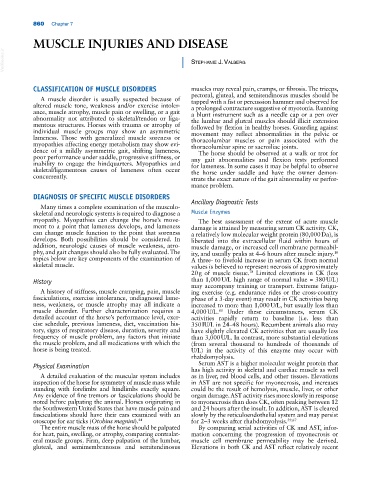Page 894 - Adams and Stashak's Lameness in Horses, 7th Edition
P. 894
860 Chapter 7
MUSCLE INJURIES AND DISEASE
VetBooks.ir stephanIe J. ValBerG
CLASSIFICATION OF MUSCLE DISORDERS muscles may reveal pain, cramps, or fibrosis. The triceps,
pectoral, gluteal, and semitendinosus muscles should be
A muscle disorder is usually suspected because of tapped with a fist or percussion hammer and observed for
altered muscle tone, weakness and/or exercise intoler a prolonged contracture suggestive of myotonia. Running
ance, muscle atrophy, muscle pain or swelling, or a gait a blunt instrument such as a needle cap or a pen over
abnormality not attributed to skeletal/tendon or liga the lumbar and gluteal muscles should illicit extension
mentous structures. Horses with trauma or atrophy of followed by flexion in healthy horses. Guarding against
individual muscle groups may show an asymmetric movement may reflect abnormalities in the pelvic or
lameness. Those with generalized muscle soreness or thoracolumbar muscles or pain associated with the
myopathies affecting energy metabolism may show evi thoracolumbar spine or sacroiliac joints.
dence of a mildly asymmetric gait, shifting lameness, The horse should be observed at a walk or trot for
poor performance under saddle, progressive stiffness, or any gait abnormalities and flexion tests performed
inability to engage the hindquarters. Myopathies and for lameness. In some cases it may be helpful to observe
skeletal/ligamentous causes of lameness often occur the horse under saddle and have the owner demon
concurrently. strate the exact nature of the gait abnormality or perfor
mance problem.
DIAGNOSIS OF SPECIFIC MUSCLE DISORDERS
Many times a complete examination of the musculo Ancillary Diagnostic Tests
skeletal and neurologic systems is required to diagnose a Muscle Enzymes
myopathy. Myopathies can change the horse’s move The best assessment of the extent of acute muscle
ment to a point that lameness develops, and lameness damage is attained by measuring serum CK activity. CK,
can change muscle function to the point that soreness a relatively low molecular weight protein (80,000 Da), is
develops. Both possibilities should be considered. In liberated into the extracellular fluid within hours of
addition, neurologic causes of muscle weakness, atro muscle damage, or increased cell membrane permeabil
phy, and gait changes should also be fully evaluated. The ity, and usually peaks at 4–6 hours after muscle injury.
10
topics below are key components of the examination of A three‐ to fivefold increase in serum CK from normal
skeletal muscle. values is believed to represent necrosis of approximately
20 g of muscle tissue. Limited elevations in CK (less
78
History than 1,000 U/L high range of normal value = 380 U/L)
may accompany training or transport. Extreme fatigu
A history of stiffness, muscle cramping, pain, muscle ing exercise (e.g. endurance rides or the cross‐country
fasciculations, exercise intolerance, undiagnosed lame phase of a 3‐day event) may result in CK activities being
ness, weakness, or muscle atrophy may all indicate a increased to more than 1,000 U/L, but usually less than
muscle disorder. Further characterization requires a 4,000 U/L. Under these circumstances, serum CK
80
detailed account of the horse’s performance level, exer activities rapidly return to baseline (i.e. less than
cise schedule, previous lameness, diet, vaccination his 350 IU/L in 24–48 hours). Recumbent animals also may
tory, signs of respiratory disease, duration, severity and have slightly elevated CK activities that are usually less
frequency of muscle problem, any factors that initiate than 3,000 U/L. In contrast, more substantial elevations
the muscle problem, and all medications with which the (from several thousand to hundreds of thousands of
horse is being treated. U/L) in the activity of this enzyme may occur with
rhabdomyolysis.
Physical Examination Serum AST is a higher molecular weight protein that
has high activity in skeletal and cardiac muscle as well
A detailed evaluation of the muscular system includes as in liver, red blood cells, and other tissues. Elevations
inspection of the horse for symmetry of muscle mass while in AST are not specific for myonecrosis, and increases
standing with forelimbs and hindlimbs exactly square. could be the result of hemolysis, muscle, liver, or other
Any evidence of fine tremors or fasciculations should be organ damage. AST activity rises more slowly in response
noted before palpating the animal. Horses originating in to myonecrosis than does CK, often peaking between 12
the Southwestern United States that have muscle pain and and 24 hours after the insult. In addition, AST is cleared
fasciculations should have their ears examined with an slowly by the reticuloendothelial system and may persist
otoscope for ear ticks (Otobius megnini). 44 for 2–3 weeks after rhabdomyolysis. 39,67
The entire muscle mass of the horse should be palpated By comparing serial activities of CK and AST, infor
for heat, pain, swelling, or atrophy, comparing contralat mation concerning the progression of myonecrosis or
eral muscle groups. Firm, deep palpation of the lumbar, muscle cell membrane permeability may be derived.
gluteal, and semimembranosus and semitendinosus Elevations in both CK and AST reflect relatively recent

